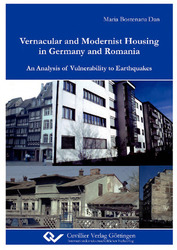| Fachbereiche | |
|---|---|
| Buchreihen (96) |
1378
|
| Nachhaltigkeit |
3
|
| Gesundheitswesen |
1
|
| Geisteswissenschaften |
2363
|
| Naturwissenschaften |
5406
|
| Ingenieurwissenschaften |
1791
|
| Allgemeine Ingenieurwissenschaften | 292 |
| Maschinenbau und Verfahrenstechnik | 861 |
| Elektrotechnik | 686 |
| Bergbau- und Hüttenwesen | 30 |
| Architektur und Bauwesen | 75 |
| Allgemein |
98
|
|
Leitlinien Unfallchirurgie
5. Auflage bestellen |
|
Erweiterte Suche
Vernacular and Modernist Housing in Germany and Romania
An Analysis of Vulnerability to Earthquakes
Maria Bostenaru Dan (Autor)Vorschau
Inhaltsverzeichnis, Datei (77 KB)
Leseprobe, Datei (680 KB)
This book contains a selection of reports contributed to the World Housing Encyclopedia project (http://www.world-housing.net/) by the author, one of them together with Eng. Ilie Sandu. The reports were selected to highlight the difference in the building typology in Romania and Germany in vernacular and respectively Modernist housing. While in Romania brick masonry in rectangular one storey construction and reinforced concrete multistory frame were the typical structural systems, in Germany frame structure out of timber and respectively steel in multistory construction reflected the different geography of resources. Closing a report of the German colonists on the territory of today’s Romania from about 300 years ago in Banat and in Sathmar county is included, in which the local vernacular typology of rectangular one storey brick masonry housing was practiced. The collection of reports is preceded by an essay deconstructing the term of Modernity in the dialogue traditional-modern in literature and architecture. Instead of postface conclusion are drawn on the common features and especially the differences in the two countries, relating the development also to late immigrants from Germany to Romania, as architect Rudolph Fraenkel was, who built one of the few buildings with steel structure to times of Modernism.
| ISBN-13 (Printausgabe) | 3869552999 |
| ISBN-13 (Printausgabe) | 9783869552996 |
| ISBN-13 (E-Book) | 9783736932999 |
| Sprache | Englisch |
| Seitenanzahl | 252 |
| Auflage | 1 Aufl. |
| Band | 0 |
| Erscheinungsort | Göttingen |
| Erscheinungsdatum | 13.04.2010 |
| Allgemeine Einordnung | Sachbuch |
| Fachbereiche |
Architektur und Bauwesen
|








